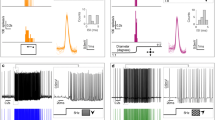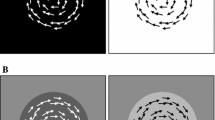Summary
-
1.
The thoracic connectives of the Acridoidea, Grylloidea and Tettigonioidea contain 2 units which appear functionally identical except that they are activated by ipsilateral and contralateral eyes respectively. They are purely visual, responding to dimming of small areas of the retina or to moving objects subtending small angles, but not to whole field stimulation (Fig. 8). The axons run from the optic lobe to the metathoracic ganglion; the contralateral unit crosses the brain in the tritocerebrum. Their relative sizes differ in the different taxa, but they appear functionally homologous.
-
2.
The common identity of the units previously described by Palka and by Rowell and Horn is established, and areas of conflict are reexamined. The units do not respond to whole field stimulation caused by movement of the animal in a structured visual field. Palka found that the response to small area stimulation was totally inhibited during such movement, whereas Rowell and Horn did not. It is shown that the inhibition is graded, and is complete only at high angular velocities; also that it wanes if movement is sustained. Both descriptions of the units are correct, but were made at different angular velocities. At medium angular velocities of the whole field the unit responds adequately to normal stimuli, but at a somewhat diminished level (Fig. 3–5).
-
3.
The units play no part in the optokinetic memory previously described in the locust (Fig. 6).
-
4.
Activity of the visual units has no direct effect on any of the major thoracic motor output systems, nor upon the behaviour of chronically implanted freely moving animals (Fig. 7).
-
5.
The occurrence, anatomy, response characteristics, afferent and efferent connections and function of the DMD units is reviewed. Their apparent specialisation for a “warning” function, plus the absence of direct motor output, leads to the speculation that they may switch the thoracic neuropile from thoracic to cerebral inputs.
Similar content being viewed by others
References
Arnett, D.: Receptive field organisation of units in the first optic ganglion of Diptera. Science, N.Y., in press (1971).
Bishop, L. G., Keehn, D. G.: Two types of neurones sensitive to motion in the optic lobe of the fly. Nature (Lond.) 212, 1374–1376 (1966).
—, McCann, G. D.: Motion detection by interneurons of optic lobes and brain of the flies Calliphora phaenicia and Musca domestica. J. Neurophysiol. 31, 509–525 (1968).
Blest, A. D., Collett, T. S.: Micro-electrode studies of the medial protocerebrum of some Lepidoptera. I. Response to simple, binocular visual stimulation. J. Insect Physiol. 11, 1079–1103 (1965).
—: Micro-electrode studies of the medial protocerebrum of some Lepidoptera. II. Response to visual flicker. J. Insect Physiol. 11, 1289–1356 (1965).
Burtt, E. T., Catton, W. T.: Visual perception of movement in the locust. J. Physiol. (Lond.) 125, 566–580 (1954).
—: Electrical responses to visual stimulation in the optic lobes of the locust and certain other insects. J. Physiol. (Lond.) 133, 68–88 (1956).
—: Transmission of visual responses in the nervous system of the locust. J. Physiol. (Lond.) 146, 492–514 (1959).
—: The properties of single unit discharges in the optic lobes of the locust. J. Physiol. (Lond.) 154 479–490 (1960).
—: A diffraction theory of insect vision. I. An experimental investigation of visual acuity and image formation in the compound eyes of three species of insects. Proc. roy. Soc. B 157, 53–82 (1962).
—: Perception by locusts of rotated patterns. Science, N. Y. 151, 224 (1966).
—: Resolution of the locust eye measured by rotation of radial striped patterns. Proc. roy. Soc. B 173, 513–529 (1969).
Catton, W. T., Chakraborty, A.: Single neuron responses to visual and mechanical stimuli in the thoracic nerve cord of the locust. J. Insect Physiol. 15, 245–258 (1969).
Chapple, W. D.: Motoneuron responses to visual stimuli in Oncopeltus fasciatus Dallas. J. exp. Biol. 45, 401–410 (1966).
Collett, T. S.: Centripetal and centrifugal visual cells in medulla of the insect optic lobe. J. Neurophysiol. 33, 239–256 (1970).
—, Blest, A. D.: Binocular, directionally selective neurones, possibly involved in the optomotor response of insects. Nature (Lond.) 212, 1330–1333 (1966).
Cosens, D. J.: Visual sensitivity in the light- and dark-adapted compound eye of the desert locust. J. Insect Physiol. 12, 871–890 (1966).
Elsner, N.: Kommandofasern im Zentralnervensystem der Heuschrecke Gastrimargus africanus (Oedipodinae). Zool. Anz., Suppl. 33, Verh. deutsch, zool. Ges. 1969, 465–471 (1970).
Horn, G., Rowell, C., H. F.: Medium and long-term changes in the behaviour of visual neurones in the tritocerebrum of locusts. J. exp. Biol. 49, 143–169 (1968).
Horridge, G. A.: Optokinetic memory in the locust. J. exp. Biol. 44, 255–262 (1966).
—, Scholes, J. H., Shaw, S., Tunstall, J.: Extracellular recordings from single neurones in the optic lobe and brain of the locust. In: The physiology of the insect central nervous system, ed. J. E. Treherne and J. W. L. Beament. London: Academic Press 1965.
Hoyle, G.: Exploration of neuronal mechanisms underlying behaviour in insects. In: Neural theory and modelling, ed. R. F. Reiss. Stanford U. P. 1964.
—: An isolated insect ganglion-nerve-muscle preparation. J. exp. Biol. 44, 413–428 (1966).
Huber, F.: Central control of movements and behavior of invertebrates. In: Invertebrate nervous systems (ed. C. A. G. Wiersma). Chicago U. P. 1967.
Ishikawa, S.: Visual response patterns of single ganglion cells in the optic lobe of the silk worm moth, Bombyx mori L. J. Insect Physiol. 8, 485–491 (1962).
Kameda, K.: Electrical acitivity of optic ganglion cells in locust (Orthoptera). Bull. Tokyo med. dent. Univ. 11, 281–295 (1964).
McCann, G. D., Dill, J. C.: Fundamental properties of intensity, form and motion perception in the visual nervous system of Calliphora phaenicia and Musca domestica. J. gen. Physiol. 53, 385–413 (1969).
Foster, S. F.: Binocular interactions of motion detection fibres in the optic lobes of flies. Kybernetik, in press (1971).
Northrop, R. B., Guignon, E. F.: Information processing in the optic lobes of the lubber grasshopper. J. Insect Physiol. 16, 691–713 (1970).
Palka, J.: Diffraction and visual acuity in insects. Science, N. Y. 149, 551–553 (1965).
—: An inhibitory process influencing visual responses in a fibre of the ventral nerve cord of locusts. J. Insect Physiol. 13, 235–248 (1967a).
—: Head movement inhibits locust visual unit's response to target movement. Amer. Zool. 7, 728 (1967b).
—: Discrimination between movements of eye and object by visual interneurones of crickets. J. exp. Biol. 50, 723–732 (1969).
Parry, D. A.: The function of the insect ocellus. J. exp. Biol. 24, 211–219 (1947).
Rowell, C. H. F.: A general method for silvering invertebrate central nervous systems. Quart. J. micr. Sci. 104, 81–87 (1963).
Rowell, C. H. F.: Variable responsiveness of the DCMD neurone in the free-moving locust, and its relation to behaviour and arousal. J. exp. Biol., in press (1971a).
- - Antennal cleaning, arousal, and visual neurone responsiveness in the locust. J. exp. Biol., in press (1971b).
—, Horn, G.: Response characteristics of neurones in an insect brain. Nature (Lond.) 216, 702–703 (1967).
—: Dishabituation and arousal in the response of single nerve cells in an insect brain. J. exp. Biol. 49, 171–183 (1968).
Satija, R. C.: Studies on the course and functions of the giant nerve fibres from the eye and the tegumentary nerve to the ventral nerve cord in Locusta migratoria. Res. Bull. Panjab Univ. 132, 511–519 (1957).
—: A histological and experimental study of nervous pathways in the brain and thoracic nerve cord of Locusta migratoria migratorioides. Res. Bull. Panjab Univ. 137, 13–22 (1958).
Suga, N., Katsuki, Y.: Vision in insects in terms of the electrical activities of the descending nerve fibres. Nature (Lond.) 194, 658–660 (1962).
Swihart, S. L.: Single unit activity in the visual pathway of the butterfly Heliconius erato. J. Insect Physiol. 14, 1589–1601 (1968).
Tunstall, J., Horridge, G. A.: Electrophysiological investigation of the optics of the locust retina. Z. vergl. Physiol. 55, 167–182 (1967).
Author information
Authors and Affiliations
Rights and permissions
About this article
Cite this article
Rowell, C.H.F. The orthopteran descending movement detector (DMD) neurones: a characterisation and review. Z. Vergl. Physiol. 73, 167–194 (1971). https://doi.org/10.1007/BF00304131
Received:
Issue Date:
DOI: https://doi.org/10.1007/BF00304131




